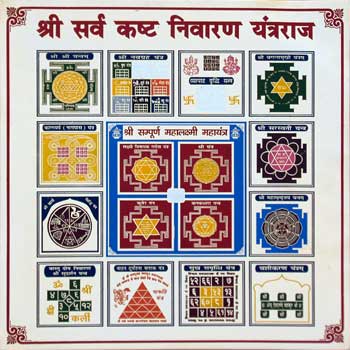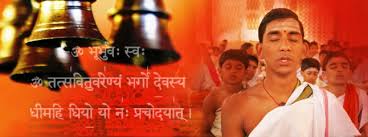- Astrology
- All Dosh
- Abhishek
- Puja Services
- Healings
- Therapies
- Meditation
- Vastu Shastra
- Attunements or ShaktiPaat
Yantra Healing & Mantra Healing
 Yantra – Yantra is a geometrical shape or a design through which by using a special picture or lines, we express the force of powers & energies of the Nature and those of our own thoughts. All these pictures,
lines or symbol are called Yantra.
Yantra – Yantra is a geometrical shape or a design through which by using a special picture or lines, we express the force of powers & energies of the Nature and those of our own thoughts. All these pictures,
lines or symbol are called Yantra.
In India, all the symbols, designs, geometrical shapes, statues of gods & goddesses come under the category of 'Yantra'. We also make 'Swastik' sign, also called "manglik" (fortunate) in which a "+" (plus) sign is made
and four clockwise lines are joined to it. Then we write our feeling on its sides – "shubh" (fortune) & "laabh" (profit). It means that may fortune & profit keep getting added up in our house from all the directions and make
us move always in forward & future-oriented direction (depicted by the four clockwise lines)
Shri Yantra' is also a geometrical design comprising 108 triangles, A triangle is a symbol of upward movement (growth & prosperity) with a strong foundation. These triangles are on all the four sides representing multi-dimensional
growth & posterity. Shri Yantra is constructed like the Mount Meru showing prosperity at each step.
Mantra Healing
 During early vedic period, Vedic poets became fascinated by the inspirational power of poems, metered verses and music. They referred
to them with the root dhi-, which evolved into dhyana (meditation) of Hinduism, and the language used to start and assist this process manifested as mantra. By middle vedic period (1000 BC to 500 BC), mantras were derived from
all vedic compositions. They included ṛc (verses from Rigveda for example), sāman (musical chants from the Sāmaveda for example), yajus(a muttered formula from the yajurveda for example), and nigada (a loudly spoken yajus).
During the Hindu Epics period and after, mantras multiplied in many ways and diversifed to meet the needs and passions of various schools of Hinduism. The tantric school posited that each mantra (bijas) is a deity. it is this
distinct school of Hinduism and 'each mantra is a deity' reasoning that led to the perception that some Hindus have tens of millions of gods
During early vedic period, Vedic poets became fascinated by the inspirational power of poems, metered verses and music. They referred
to them with the root dhi-, which evolved into dhyana (meditation) of Hinduism, and the language used to start and assist this process manifested as mantra. By middle vedic period (1000 BC to 500 BC), mantras were derived from
all vedic compositions. They included ṛc (verses from Rigveda for example), sāman (musical chants from the Sāmaveda for example), yajus(a muttered formula from the yajurveda for example), and nigada (a loudly spoken yajus).
During the Hindu Epics period and after, mantras multiplied in many ways and diversifed to meet the needs and passions of various schools of Hinduism. The tantric school posited that each mantra (bijas) is a deity. it is this
distinct school of Hinduism and 'each mantra is a deity' reasoning that led to the perception that some Hindus have tens of millions of gods
The most basic mantra is Om, which in Hinduism is known as the "pranava mantra," the source of all mantras. The Hindu philosophy behind this is the premise that before existence and beyond existence is only One reality,
Brahma, and the first manifestation of Brahma expressed as Om. For this reason, Om is considered as a foundational idea and reminder, and thus is prefixed and suffixed to all Hindu prayers. While some mantras may invoke individual
Gods or principles, fundamental mantras, like the 'Shanti Mantra,' the 'Gayatri Mantra' and others all ultimately focus on the One reality.
Mantra japa is a practice of repetitive muttering the same mantra for an auspicious number of times, the most popular being 108, and sometimes just 5, 10, 28 or 1008.[3][41][42]Japa is found in personal prayer or meditative
efforts of some Hindus, as well during formal puja (group prayers). These japas are assisted by malas (bead necklaces) containing 108 beads and a head bead (sometimes referred to as the 'meru', or 'guru' bead). The devotee
performing japa using his/her fingers counts each bead as he/she repeats the chosen mantra. Having reached 108 repetitions, if he/she wishes to continue another cycle of mantras, the devotee turns the mala around without crossing
the head bead and repeats the cycle.[43] Japa-yajna is claimed to be most effective if the mantra is repeated silently in mind (manasah)
The Gayatri mantra is considered one of the most universal of all Hindu mantras, invoking the universal Brahman as the principle of knowledge and the illumination of the primordial Sun. The mantra is extracted from the
10th verse of Hymn 62 in Book III of Rig Veda.
'ॐ भूर्भुवस्व: | तत्सवितुर्वरेण्यम् | भर्गो देवस्य धीमहि | धियो यो न: प्रचोदयात्'' ''Oṁ Bhūr Bhuva~Swah' Tat Savitur varenyam bhargo devasya dhīmahi dhiyo yo nah prachodayāt
Courses Offered





































